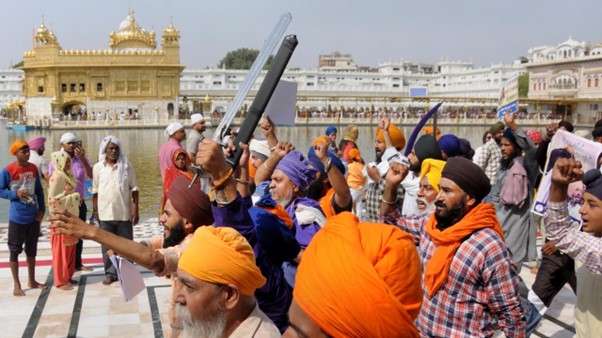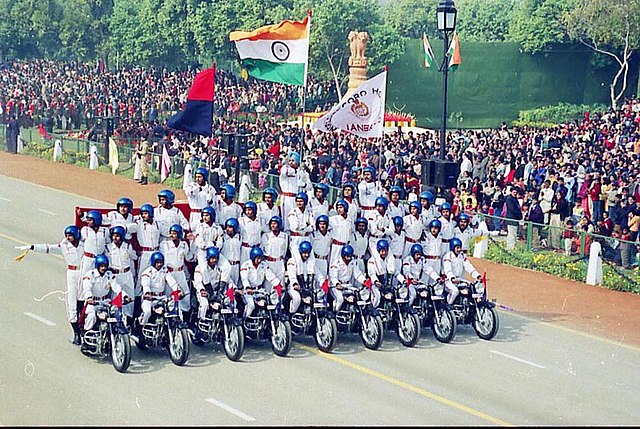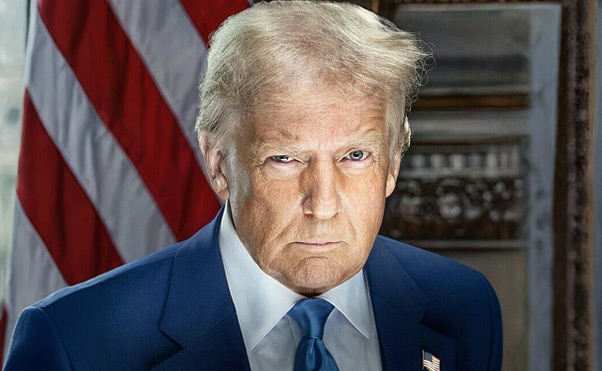
Punjab – Seeking Way Forward In Simmering Crisis

Introduction
Role models like Rishi Sunak, PM of the UK, and Ajay Banga, recently appointed President of World Bank, bolster Punjab’s image, giving it a larger-than-life narrative. The community is characterized by an adventurous and industrious spirit, very visible and known to be punching, much above its weight classification, notwithstanding, small numbers. Unfortunately, back home, Punjab and Punjabis have been in the news, mostly for the wrong reasons. The unending chase of the self-appointed head of Waris-Punjab-De (WPD), Amritpal Singh turned into tragi-comic drama and charade, finally leading to his apprehension after more than a month-long, hit-and-miss chase. Punjabis have been spearheading unresolved farmers’ agitation, which has been unfairly dubbed as a ‘Khalistan’ linked movement.
Dominant Narratives. The two dominant narratives are drug addiction (‘udta’ or delirious Punjab) and the threat of revival of the separatist Khalistan movement. This erodes the image of farmers, sportsmen, and enablers of the green revolution as also numerous much-acclaimed, charity initiatives by organizations like Khalsa Aid. Even abroad, especially in Canada, some Punjabis are embroiled in drug trade and extortion. The recent shooting of top UN designated gangster, Amarpal Singh in Canada, attacks on Hindu temples in Australia, and violent protests and attempts to ransack the Indian High Commission in London are ominous trends. The recent report by Colin Bloom, a reputed and independent faith engagement advisor of the UK government has recommended a detailed investigation into pro-Khalistan activists and applying necessary correctives. Many such maladies have been soft-pedaled in Canada, UK, and Australia, allegedly due to the compulsion of vote-bank politics. It will be appropriate to examine emerging challenges and flag appropriate coping strategies.
Challenges
Demographic and Theological Environment. Punjabi society has traditionally been syncretic with a tolerant, multi-faith character, living in harmony. The approximate demographic distribution is – Sikhs (57 %), Hindus (38%), Muslims (2%), and a visibly increasing number of Christians (2%). The culture is referred to as Punjabiyat and the inclusive faith as ‘Nanak Naam Lewa’, with Sufi influences. Punjab has approximately 32% Scheduled Caste (SC), Dalit population, divided into Ramdasias, Mazhabis, Kabeer-panthis, Ravidasias, and Adi-Dharmis sects, often jostling among themselves. This is the highest percentage of SC in a state. Unfortunately, the Sikh religion has been taken over by Gurdwara tussles and competitive extremism and has got intertwined with mainstream politics. This has resulted in the sprouting of Deras (seminaries) and Sants (spiritual heads), some even with private militias. The overarching religious body, Shiromani Gurdwara Prabandhak Committee (SGPC) has been forced to yield control of Nanded Sahib and Patna Sahib, temporal seats, referred to as Takhats. Similarly, DGPC and HGPC have come up in Delhi and Haryana. A new trend is fomenting societal tensions, by orchestrating sacrilegious acts (described as Be-adbi) like the Baragari incident, wherein the holy book is desecrated by mischievous elements. Another notable phenomenon is faith healing camps to convert poor Dalits.
K2 Conundrum. Pakistan is reportedly running Kashmir-Khalistan (K2) project through ISI, aimed at reviving the Khalistan movement even when the situation in Kashmir is improving. A large number of extremist leaders are operating from Pakistan. The recent shooting down of dreaded and wanted Khalistan Commando Force Chief, Paramjit Singh Panjwar in Lahore corroborates this fact. As a corollary, there are regular reports of sightings and shooting down of drones, by security agencies. Drone-Drug combo is being misused by narco-terrorism mafia across the border, to drop weapons besides drugs, of course in connivance with agencies and Rangers across. It is fairly apparent that currently, Khalistan and separatism have no real traction within Punjab. The old generation still recalls the difficult period and ‘Santaap’ (suffering) during the 80s and 90s. The fact that Amritpal and his movement failed to gain traction and he was described as Bhagoda (absconder), amply proves their irrelevance. However, the movement simmers abroad amongst the diaspora with sporadic, high TRP-grabbing incidents, aided by complicit elements in authority.
Agrarian Complexities. Punjab continues to be the granary of the nation with a record-breaking output. The overflowing granaries enabled the free grain scheme, which provided much-needed relief during the COVID-19 pandemic and Ukrainian conflict, which had disrupted grain supply. However, the ‘rice-wheat’ cropping pattern is an irrigation-intensive process resulting in the water table receding/depleting and creating a specter of looming water stress. Burning of crop residue along with other factors creates choking environmental pollution in National Capital Region (NCR). Rampant use of chemical fertilizers and pesticide have poisoned soil and water leading to a high incidence of health hazards like cancer. Land holdings have become smaller and farming is done by contracted migrant labour, which is creating demographic challenges.
Socio-political Determinants. The politics are a complex cocktail of theologically inclined parties like factions of Akali Dal. The unprecedented majority given to Aam Admi Party (AAP) was essentially a rejection of established parties. Punjabi society is characterized by a few defining peculiarities. These include- first, an overbearing sense of skepticism. This also leads to Punjab being perpetually out of step with central authority manifesting in non-ruling (opposition) parties like AAP, at the helm of state. Second, the youth need persuasion and sensitive handling as Punjabi nature is described in the seminal quote, “Pyar naal saadi jaan bhi le lo, Jora-Mardi naal, assi pinde di joon bhi nahi deni”. It means that with love, you can ask for our life but with coercion and force, we shall not part with even unwanted lice, on our body. This often is mistaken as entitlement or bullying, which is avoidable.
Third, if convinced about a sense of fair play and the right cause, the very same lot is willing to blindly follow the leader. The caveat is that leadership has to be earned, as we see in Sikh soldiers and the response of soldiers and rural peasantry in the 1965 and 1971 wars. Most importantly, the Green Revolution, transforming the starving PL-480 dependent, ship-to-mouth national economy into grain exporting one, bears reiteration on this account. Fourth, Punjabi youth is aspirational and is willing to live on the edge and increasingly seeks greener pastures through migration. This has resulted in eulogizing of gangsters, guns, and even drugs. Ironically, even those aspiring to drive trucks, prefer to do it in Canada and USA. Most importantly, Central Government has undertaken multiple initiatives including emotive ones like recognizing the martyrdom of Sahebzadas (sons of Guru Gobind Singh), yet it requires more efforts, to overcome persistent skepticism amongst society.
Way Forward
The solution to Punjab’s woes mandates multi-dimensional and focused long-term commitment. It is high time that the law-and-order mechanism in the border state is sorted out. Pakistan is hell-bent on prosecuting K2 (Kashmir-Khalistan) project, it is axiomatic that the Police and Central Agencies should be synergistic and stay focused on operations and keep out of partisan politics. The reality is that state administrative and police cadres are divided along political affiliations with incessant inter and intra-cadre tussles. Supreme Court-mandated reforms, outlined in the Prakash Singh Committee report need to be applied post-haste.
Externally, hierarchy and diplomats have red-flagged extremist tendencies and pressure has to be kept up, as these governments tend to pander to vote banks. It is also necessary that those identified as dubious are denied reciprocal citizenship benefits like Overseas Citizens of India (OCI) and Non-Resident Indian (NRI) privileges. The problem has political dimensions, wherein theologically inclined parties are sprouting factions, which seek recognition, by positioning themselves on the extremist fringes. The established parties owe it to Punjab to forge Punjabiyat and inclusive ‘Nanak Naam Lewa’ culture. In the long term, it is all about tackling socio-economic problems, primarily enabling Green-revolution-2.0, skill-building, and building an eco-system for employment to reclaim the lost glory of Punjab.
The bottom line is that problems, although serious, are manageable and flagged. Given the right catalysts- meaningful leadership, commitment, and central initiatives, Punjabis being self-starters are blessed with legendary resilience and improvisation (jugaad). They have it in them to rebound. Meanwhile, the diaspora should contribute by anchoring meaningful initiatives, back home but most importantly, desist from supporting malevolent elements and fissiparous tendencies.
*********************************************************************************************************************
Note:
Social media has been buzzing about a highly condemnable video of a Float depicting Assassination of India’s former PM Indira Gandhi which was part of a Parade taken out in Brampton, Canada by Khalistan supporters. India’s External Affairs Minister, Dr S Jaishankar reacted saying that such incidents are not good for India – Canada relations. This article is a timely one looking at the root causes of the problem.
Disclaimer
The opinions expressed in this article are the author’s own and do not reflect the views of Chanakya Forum. All information provided in this article including timeliness, completeness, accuracy, suitability or validity of information referenced therein, is the sole responsibility of the author. www.chanakyaforum.com does not assume any responsibility for the same.
Chanakya Forum is now on . Click here to join our channel (@ChanakyaForum) and stay updated with the latest headlines and articles.
Important
We work round the clock to bring you the finest articles and updates from around the world. There is a team that works tirelessly to ensure that you have a seamless reading experience. But all this costs money. Please support us so that we keep doing what we do best. Happy Reading
Support Us















POST COMMENTS (1)
Kalidan Singh